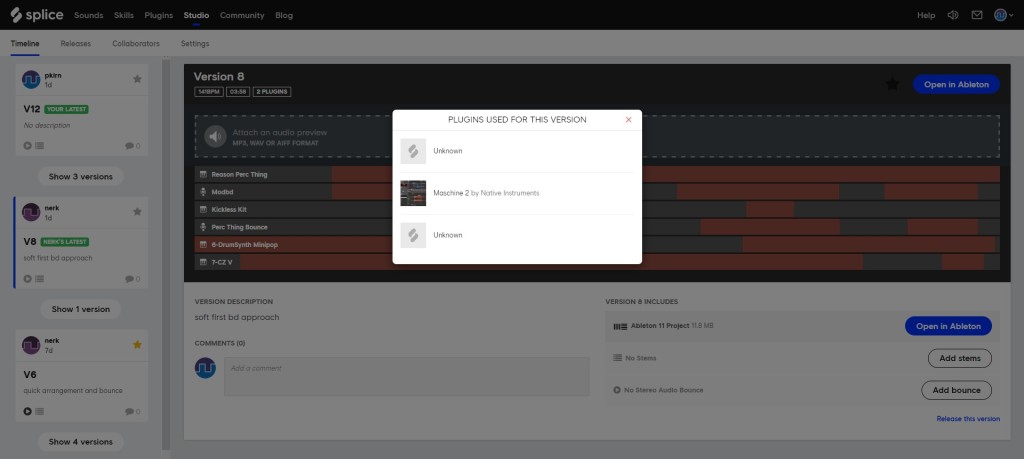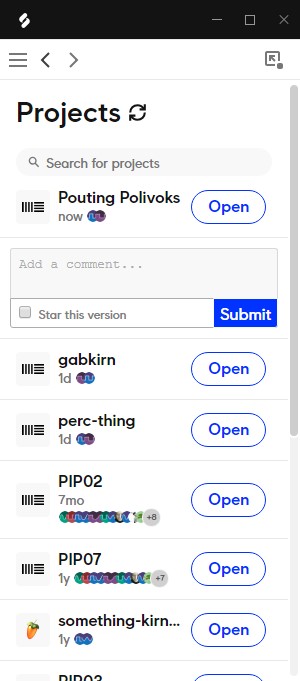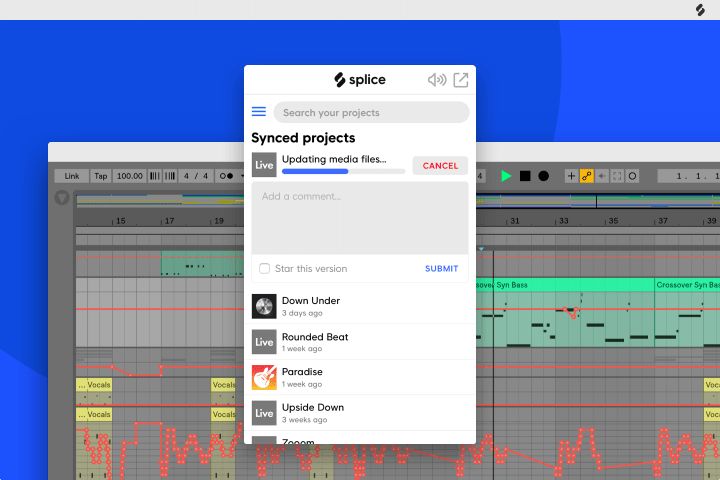How to Upload and Fl Studio in to Splice
A lot of the solutions you'll see for "collaborating" involve live jamming – fifty-fifty though that's not always what you want. Splice Studio is a gratis style to keep a project backed upwards and synced, which is useful solo merely absolutely indispensable when working with others.
The thought is this – a common way of collaborating betwixt two or more people is to pass around a single session file from a DAW. That ways you need to go along track of unlike versions and changes and exist able to open up an earlier version in case someone makes a fault, does something you don't like, or you but desire to refer back to an earlier iteration. It's what'southward called version command, and information technology'southward also a bully grade of backup.
Since backing up files and keeping runway of changes is useful solo, that is as well a use case – though it'southward less enervating than when other people are involved. Y'all could theoretically use the same version control solutions developers do with software. (I'm playing now with Plastic SCM which may work as a nerdier solution, just I'll talk well-nigh that another fourth dimension.)
The advantage of Splice Studio is, it's already aware of particular project types out of the box. That means it tin display more helpful information – fifty-fifty showing you track names, uncomplicated visualizations, and which plug-ins were used. (A competing tool called Gobbler did something like this, only they've largely pivoted to focus mainly on their plug-in subscriptions, and Splice e'er had the near features.)

I actually notice it's just as easy to ignore Splice's plug-in direction tools, and go alee and bounce audio rather than concern myself with syncing upwardly plug-ins. That's not just a practical business concern – though yeah information technology gets yous away from worrying which license people have. It'due south likewise a good way to commit to decisions. A widely-known manner of tricking yourself into completing tracks is to go ahead and regularly record sound. It avoids confusion, lost parameters, and generally makes producing a little more like live playing.
The keen thing about Splice Studio is – it'south free, and information technology (mostly) works well, with a range of different tools. Nothing against Splice's other offerings – yes, there are hooks to endeavor out samples and sound packs or subscribe to plug-ins. And maybe fifty-fifty a plug-in subscription is a good way to sync up more involved collaborations. But I think Splice Studio is good enough to talk about on its own.
Y'all'll find Studio listed on the Splice menu bar – that'southward the sync-up tool.

You need a Splice account to use Splice Studio, but that's information technology – and at that place'due south really no nagging; y'all won't even see the options for soundware and plug-ins unless y'all open the hamburger menu on the upper left-hand corner.
The DAW support is focused on a handful of tools, but hits a lot of the nigh pop choices:
- Ableton Alive
- FL Studio
- Apple Logic Pro Ten and GarageBand
- PreSonus Studio One
I'm a little sad Reaper and Reason Studios don't brand the cut, every bit they're also popular for this sort of thing, but y'all tin e'er share stems (and I'll look at how to do something like this for other tools and OSes separately).
There's a Splice app for Mac and Windows, which has a handy pop-up card that shows you projects with the latest versions. You can also speedily write in revisions when you commit – erm, when you save projects.

Really the biggest limitation of Splice is that synced projects need to be in the Splice project folder. You can move that location (Gear icon/Preferences > Splice Folder), but you tin't use more than ane location at a time.
That said, the whole package is gratis, and yous accept free unlimited storage forever.

A lot of collaboration tools make some abrasive assumptions – they think you lot want to exercise everything real-time, they recollect you want to switch tools, they believe you accept a really nifty connection at home and in the studio (as opposed to the crap bandwidth nosotros accept in reality), and they think you want to share everything publicly for some reason.
Splice Studio does none of these things. Your projection is private past default, and you but add users. It uploads when you salvage, you download, and y'all go.
Now, non all of that works perfectly every time. You practise have do a little coordination to brand sure yous aren't simultaneously working on the same projection – my friend and I were chatting back and forth on Telegram. Just that's pleasant enough anyway, and something y'all normally exercise when collaborating. (You still won't overwrite changes – that'southward the reward of version control.)
Very occasionally y'all may striking a glitch – for some reason, my colleague simply found some orphaned freeze files – but the backup and version control tend to work very well. (I'm checking up on that freeze outcome and will update this story.)
I'm curious who else is using this tool and if y'all have some tips. And I'm very curious if folks are trying some general-purpose version control for the same job.
But all said, information technology's hard to beat Splice'south free unlimited storage and DAW compatibility. It's a must with these DAWs, for sure. There are so many cases that to me actually fit this kind of tool – checking mixes, providing remix sessions, distance collaboration, and and then on.
Check it out, and we'll keep those kinds of collaboration ideas coming. Berlin is pending new lockdowns and pretty much nowhere is able to travel and gig, so now is an ideal time to cease some music and share that process with others.
https://splice.com/features/studio
Disclaimer: I wouldn't use this for critical file fill-in. I realize I had idea something merely non really said it explicitly, and information technology should exist said. I don't trust Splice as a backup service for critical files. I call up it can be a nice complement to your existing backup routine – unlimited space, version control, runs in the background when you save. But it's a free add-on to a paid service rather than a mission-critical service offering.
And then for example, if I was finishing a years-long album, I'd put that backup somewhere else, besides. If I had session files I was using for a alive set, if I had a critical film scoring project – actually anything I care about, I would stick that elsewhere.
The easiest way to solve this is merely to have some redundancy in your backup plan so forget about information technology. I utilize Backblaze and accept been fairly happy with it. Online backup with a manual copy on a second bulldoze is pretty easy to do (and makes recovery stupidly simple – you just regularly relieve the project to two drives each time there'due south a major revision). Or you could run Splice aslope your backup routine.
The main affair is, accept your files in more 1 place, keep them easy to reach, and ready backup so that y'all actually don't accept to practice or remember anything. That makes Splice a useful part of that, as long as you don't rely on information technology exclusively. We're all lazy – find the fill-in that requires you to do nothing, brand it complete so it covers everything, have your critical stuff in more one place, and you'll be fine.
Source: https://cdm.link/2021/04/splice-studio-is-free-backup-version-control-and-collaboration-for-your-daw/
0 Response to "How to Upload and Fl Studio in to Splice"
Publicar un comentario